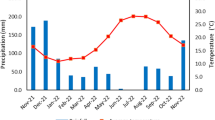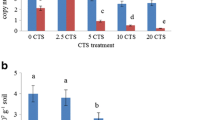Abstract
The combined effects of soil solarization and application of compost of various maturity levels upon soil microbial activity were studied under field conditions during 2010–2012. Eight treatments were divided into solarized and non-solarized treatments, and each was either non-amended or annually amended with compost at 6 kg (DW) m-2. The composts were mature, partially mature, or immature. In all three tested parameters of microbial activity (respiration rate, heat output, and dehydrogenase activity) the immature compost showed higher activity than the other compost types. Soil samples were collected weekly in order to assess microbial activity, which was evaluated from measurements of soil respiration rate, heat output, and dehydrogenase activity. Significant and year-to-year reproducible differences in all three parameters were observed between soils amended with the three compost types. Some residual (carry-over) effects of previous-year treatments were obtained. Microbial activity decreased in both solarized and non-solarized treatments during the experimental period, probably because of increasing summer temperatures, but the decline was sharper in the solarized treatments probably due to oxygen deficiency under the tarp. Significantly higher activity was found in the treatments amended with the immature compost, both in the solarized and non-solarized treatments. This could be a result of the high level of dissolved organic matter in the immature compost, which enhanced microbial activity.





Similar content being viewed by others
References
Barros, N., Gallego, M., & Feijoo, S. (2007). Sensitivity of calorimetric indicators of soil microbial activity. Thermochimica Acta, 458, 18–22.
Berry, E. D., Millner, P. D., Wells, J. E., Kalchayanand, N., & Guerini, M. N. (2013). Fate of naturally occurring Escherichia coli O157:H7 and other zoonotic pathogens during minimally managed bovine feedlot manure composting processes. Journal of Food Protection, 76, 1308–1321.
Blok, W. J., Lamers, J. G., Termorshuizen, A. J., & Bollen, G. J. (2000). Control of soilborne plant pathogens by incorporating fresh organic amendments followed by tarping. Phytopathology, 90, 253–259.
Chen, M. H., & Nelson, E. B. (2012). Microbial-induced carbon competition in the spermosphere leads to pathogen and disease suppression in a municipal biosolids compost. Phytopathology, 102(6), 588–596.
Chen, Y., Katan, J., Gamliel, A., Aviad, T., & Schnitzer, M. (2000). Involvement of soluble organic matter in increased plant growth in solarized soils. Biology and Fertility of Soils, 32, 28–34.
Cytryn, E., Kautsky, L., Ofek, M., Mandelbaum, R. T., & Minz, D. (2011). Short-term structure and functional changes in bacterial community composition following amendment with biosolids compost. Applied Soil Ecology, 48, 160–167.
Davis, J. R., Huisman, O. C., Everson, D. O., & Schneider, A. T. (2001). Verticillium wilt of potato: a model of key factors related to disease severity and tuber yield in south eastern Idaho. American Journal of Potato Research, 78, 291–300.
Gamliel, A., & Katan, J. (1991). Involvement of fluorescent Pseudomonas and other micro-organisms in increased growth response of plants in solarized soils. Phytopathology, 81, 494–502.
Gamliel, A., & Stapleton, J. J. (1993). Effect of chicken compost or ammonium phosphate and solarization on pathogen control, rhizosphere microorganisms, and lettuce growth. Plant Disease, 77, 886–891.
Gamliel, A., Grinstein, A., & Katan, J. (1997). Improved technologies to reduce emission of methyl bromide from fumigated soil. Phytoparasitica, 25, 21–30.
Gamliel, A., Austerweil, M., & Kritzman, G. (2000). Non-chemical approach to soilborne pest management - organic amendments. Crop Protection, 8, 847–853.
Garcia-Gil, J. C., Plaza, C., Soler-Rovira, P., & Polo, A. (2000). Long-term effects of municipal solid waste compost application on soil enzyme activities and microbial biomass. Soil Biology & Biochemistry, 32, 1907–1913.
Kaewruang, W., Sivasithamparam, K., & Hardy, G. E. (1989). Use of soil solarization to control root rots in gerberas (Gerbera jamesonii). Biology Fertility Soils, 8, 38–47.
Kanaan, H., Medina, S., Krassnovsky, A., & Raviv, M. (2015). Survival of Macrophomina phaseolina s.l. and Verticillium dahliae during solarization as affected by composts of various maturities. Crop Protection, 76, 108–113.
Katan, J., Greenberger, A., Alan, H., & Grinstein, A. (1976). Solar heating by polyethylene mulching for the control of diseases caused by soil-borne pathogens. Phytopathology, 66, 683–688.
Klein, E., Katan, J., & Gamliel, A. (2011). Combining residues of herb crops with soil heating for control of soilborne pathogens in a controlled laboratory system. Crop Protection, 30, 368–374.
Kurt, S., & Betul, E. (2004). Effect of soil solarization, chicken litter and viscera on populations of soil, soilborne fungal pathogens and pepper growth. Plant Pathology Journal, 3, 118–124.
Liu, B., Tu, C., Hu, S., Gumpertz, M. L., & Ristaino, J. B. (2007a). Effect of organic, sustainable, and conventional management strategies in grower fields on soil physical, chemical, and biological factors and the incidence of Southern blight. Applied Soil Ecology, 37, 202–214.
Liu, B., Tu, C., Hu, S., Gumpertz, M. L., & Ristaino, J. B. (2007b). Long term effects of organic and synthetic soils fertility amendments on soil microbial communities and the development of Southern blight. Soil Biology& Biochemistry, 39, 2302–2316.
Medina, S., Raviv, M., Saadi, I., & Laor, Y. (2009). Methodological aspects of microcalorimetry used to assess the dynamics of microbial activity during composting. Bioresource Technology, 20, 4814–4820.
Messiha, N., Van Diepeningen, A., Wenneker, M., Van Beuningen, A., Janse, J., Coehen, T., Termorshuizen, A., Van Bruggen, A., & Blok, W. (2007). Biological soil disinfestation (BSD), a new control method for potato brown rot, caused by Ralstonia solanacearum race 3 biovar 2. European Journal of Plant Pathology, 117, 403–415.
Nunez-Regueria, L., Proupin-Castineiras, J., Rodriguez-Anon, J. A., Villanueva-Lopez, M., & Nunez-Fernandez, O. (2006). Design of an experimental procedure to assess soil health state. Journal of Thermal Analysis and Calorimetry, 82(2), 271–277.
Palese, A. M., Giovannini, G., Lucchese, S., Dumontet, S., & Perucci, P. (2004). Effect of fire on soil C, N and microbial biomass. Agronomie, 24, 47–53.
Raviv, M., Zaidman, B., & Kapulnik, Y. (1998). The use of compost as a peat substitute for organic vegetable transplants production. Compost Science & Utilization, 6, 46–52.
Raviv, M., Oka, Y. B., Katan, J., Hadar, Y., Yogev, A., Medina, S., Krasnovsky, A., & Ziadna, H. (2005). High-nitrogen compost as a medium for organic container-grown crops. Bioresource Technology, 96, 419–427.
Rogers, B. F., & Tate, R. L. (2001). Temporal analysis of the soil microbial community along a toposequence in Pineland soils. Soil Biology and Biochemistry, 33, 1389–1401.
Scopa, A., & Dumontet, S. (2007). Soil solarization: effects on soil microbiological parameters. Journal of Plant Nutrition, 30, 537–547.
Serra-Wittling, C., Houot, S., & Barriuso, E. (1995). Soil enzymatic response to addition of municipal solid-waste compost. Biology and Fertility of Soils, 20, 226–236.
Tamietti, G., & Valentino, D. (2006). Soil solarization as an ecological method for the control of Fusarium wilt of melon in Italy. Crop Protection, 25, 389–397.
Tate, R. L. (2000). Soil microbiology (2nd ed.). New York: John Wiley & Sons. Inc.
Yogev, A., Laor, Y., Katan, J., Hadar, Y., Cohen, R., Medina, S., & Raviv, M. (2011). Does organic farming increase soil suppression against Fusarium wilt of melon? Organic Agriculture, 1, 203–216.
Acknowledgements
This research was supported by a grant (US-4266-09R) from the US-Israel Binational Agricultural Research and Development Fund (BARD) to MR and DM. We thank Professor Y. Katan for his help and Dr. R. Cohen and Dr. E. Cytrin for a critical reading of this manuscript.
Author information
Authors and Affiliations
Corresponding author
Electronic supplementary material
Below is the link to the electronic supplementary material.
Supplementary Material Fig. 1
(DOCX 67 kb)
Supplementary Material Fig. 2
(DOCX 51 kb)
Supplementary Material Fig. 3
(DOCX 51 kb)
Supplementary Material Fig. 4
(DOCX 109 kb)
Supplementary Material Fig. 5
(DOCX 50 kb)
Supplementary Material Fig. 6
(DOCX 51 kb)
Supplementary material Table 1
(DOCX 16 kb)
Supplementary material Table 2
(DOCX 20 kb)
Rights and permissions
About this article
Cite this article
Kanaan, H., Minz, D., Medina, S. et al. The interdependent effects of solar disinfestation and compost maturity level on soil microbial activity. Phytoparasitica 44, 55–64 (2016). https://doi.org/10.1007/s12600-015-0501-2
Received:
Accepted:
Published:
Issue Date:
DOI: https://doi.org/10.1007/s12600-015-0501-2




